Light trails and how to photograph them: settings and techniques.
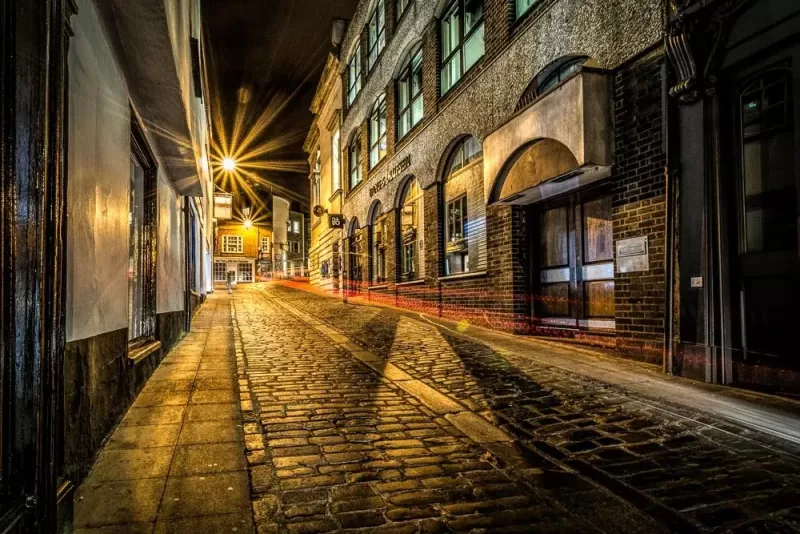
Capturing light trails proves truly magical, especially when it comes to capturing the dynamism and energy of vehicles in motion along city streets. This art form, commonly known as "vehicle light trails" or "light trail photography," allows for the creation of extraordinary and dynamic images that tell a story of speed and movement.
In this article, we will delve deep into the art of immortalizing light trails, sharing tips, techniques, and targeted settings to assist you in creating captivating images.
Essential Equipment for Light Trail Photography
Before embarking on the journey, it is essential to equip yourself with the right gear. Here are the indispensable items to include in your kit for shooting light trail photos:
1. DSLR or Mirrorless Camera
Opt for a camera with manual settings and excellent performance in low-light conditions. It doesn't need to be expensive, but make sure it can be used in full manual mode and supports shooting in RAW image format.
2. Sturdy Tripod
A stable tripod is crucial to keep the camera steady during long exposures. Avoid thin and fragile tripods, as they won't provide the necessary stability.
3. Remote Shutter Release
A remote shutter release device will allow you to trigger the shutter without touching the camera, reducing the risk of vibrations during long exposures.
4. Fully Charged Battery and Empty Memory Card
Ensure you have a fully charged battery and a memory card with ample available space. Extended shooting sessions, especially in cold conditions, can quickly deplete battery life.
5. (Optional) Ultra-Wide Angle Lens
If possible, consider using a lens with an ultra-wide field of view. This will allow you to capture more extensive portions of the scene, ideal for including large buildings and bridges in a single frame. For example, a focal length of 16mm on a full-frame camera, 10mm on a crop sensor camera, and 8mm on a micro 4:3 camera would offer this capability.
Prepare adequately with this equipment, and you'll be ready to capture magical moments along your photographic journey.
Location Scouting
The accurate choice of location is a fundamental element in capturing captivating light trails left by vehicles. While the presence of smooth traffic is a priority, considering an interesting background is equally crucial. Essentially, your gaze should traverse and surround the light trails to embrace a scene that is enticing and engaging. Sometimes, capturing beautiful light trails alone might not be sufficient!
This is why safety is a priority! Fast-moving vehicles and photographers don't always mix well, so maintaining safe distances is imperative!
To guide you in selecting the perfect location, here are some ideas and insights on how to explore and identify the ideal spots.
Urban Landscapes
Urban settings present authentic treasure troves of visual opportunities. Head to the bustling streets of the city, where imposing skylines or iconic monuments serve as impactful backdrops. These environments create a dynamic background, perfect for capturing the enchantment of lights streaking between passing vehicles.
Bridges and Overpasses
Structures like bridges and overpasses not only enrich the architectural panorama but also offer privileged vantage points. The elevation of these places allows you to immortalize the flow of traffic—or, on some occasions, the passage of a train—from unique angles, bringing visually engaging compositions to life.
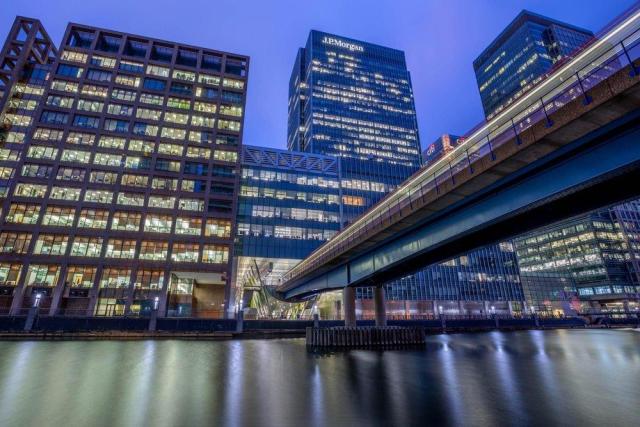
Winding Roads and Countryside
Move away from urban environments and venture into winding roads that traverse picturesque countryside landscapes. The harmonious contrast between natural elements and the bright streaks created by vehicles can give life to visually impactful compositions. Don't limit yourself to cities; embrace the beauty of scenic roads winding through rural settings.
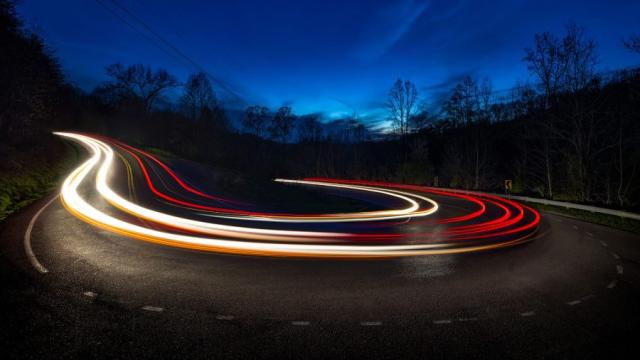
Coastal Roads
If you're fortunate enough to be near the coast, take the time to capture light trails along coastal roads. The reflection of vehicle lights on the water's surface can add a fascinating and magical touch to your images. Leverage the allure offered by the meeting of bright streaks and the sea, creating compositions that capture the unique beauty of this coastal experience.
Architectural Points of Interest
Venture into historical city centers where cobbled streets and historically imbued buildings come together to create a picturesque and timeless backdrop for your photographs. These settings provide a unique character and timeless charm to the dynamic nature of vehicle trails. Discover the magic of capturing modernity in an affectionate embrace with history, giving your images an aura of authenticity and suggestion.
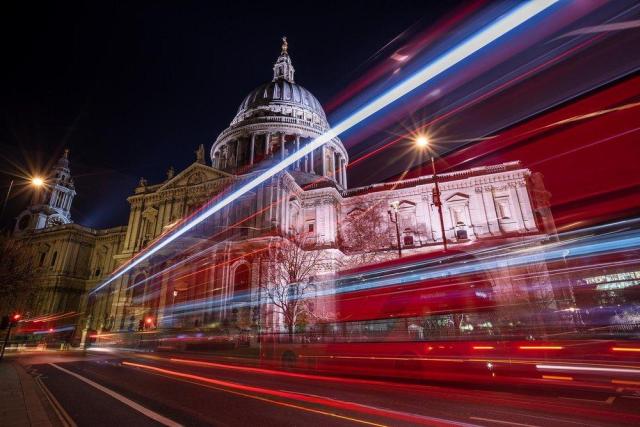
Futuristic Architecture
On the flip side, let yourself be fascinated by modern and futuristic architectural designs, capable of creating visually stimulating environments. Search for places adorned with elegant buildings, captivating lighting, and unique structures. These futuristic settings invite you to explore the blend of human creativity and technology, providing extraordinary spaces to capture compelling and aesthetically impactful images.
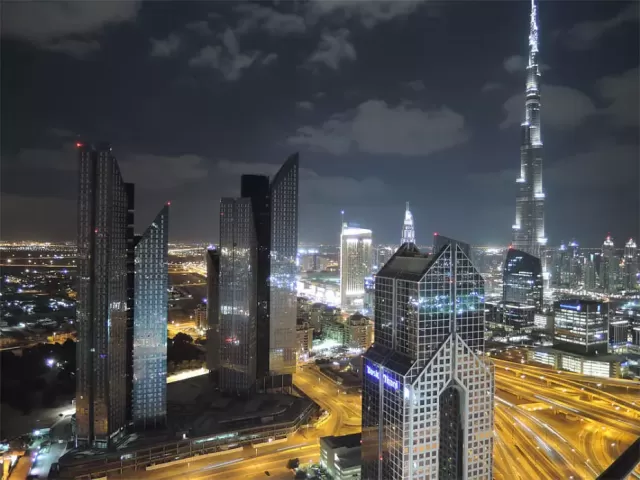
Safety Considerations
First and foremost, ensuring that the chosen location is safe for both you as a photographer and pedestrians is imperative. Avoid obstructing traffic flow and jeopardizing yourself or others while setting up equipment. Safety should always be at the forefront of your photographic experience, allowing you to fully focus on creating extraordinary images without compromising your safety or that of others.
Legal Considerations
It's crucial to be aware of local regulations regarding photography in different areas. Some locations might impose restrictions, so it's essential to identify visually appealing places that are also legally accessible. Respecting local rules not only preserves the legal integrity of your photographic activity but also allows you to discover places that, besides being aesthetically rewarding, align with local laws and regulations.
Weather Effects
Consider the impact of weather conditions on the outcome of your shots. Rainy or foggy days can add drama and atmosphere to your images, creating a suggestive and unique setting. On the other hand, clear nights can provide you with sharp and well-defined light trails, accentuating the clarity and precision of your compositions. Adapt to weather variations to create shots that seamlessly harmonize with the atmosphere of the moment.
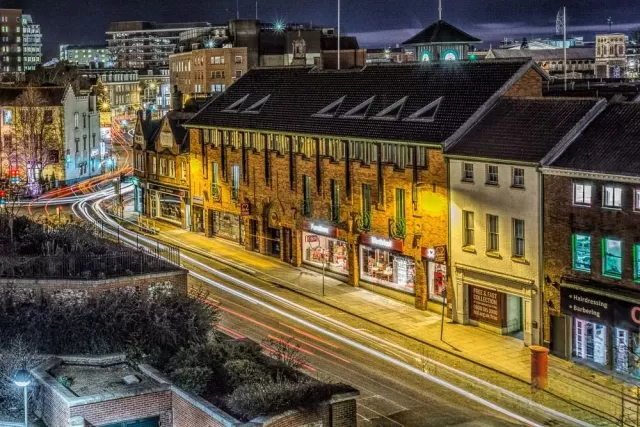
easonal Changes
Different seasons open the door to unique elements that can enrich your compositions. Capturing light streaks against a backdrop of autumn foliage or a snowy landscape can infuse a seasonal touch and a peculiar magic into your images. Take advantage of the seasonality to create compositions that capture the changing beauty of nature, adding a distinctive temporal element to your extraordinary photographs.
Test Shots and Preliminary Reconnaissance
To ensure the success of your nighttime light trails photography, it's crucial to visit potential locations during the day to familiarize yourself with the surrounding environment. Identify observation points and interesting features that could transform into true nighttime spectacles with light trails. Here's where your phone comes into play—a quick and portable companion that eliminates the need to set up your DSLR in advance. Most modern phones offer a range of focal lengths, allowing you to anticipate how the scene will look both with a wide-angle and with compression achieved through a zoom lens. This preliminary knowledge will be valuable for setting the right lens before arriving at the location.
Choosing the ideal location requires a careful balance between visual aesthetics, safety, and practical considerations. By exploring different settings and assessing the unique features of each location, you'll be better prepared to create light trail photos of vehicles that are not only visually stunning but also technically optimal.
Composition
Creating compelling compositions is essential when working with light trails. It's not just about capturing the movement of lights; it's about telling a visual story that engages the viewer and guides their gaze through the frame. There are various compositional techniques, but below are some I consider most effective for light trail photography.
Dynamic Foreground
Enhance your shots by adding foreground elements that provide depth and context. These elements can vary from a parked car to a road sign, a human figure to the reflection of a building or monument. Introducing foreground elements will not only anchor the image but also give a sense of scale, allowing viewers to fully immerse themselves in your composition.
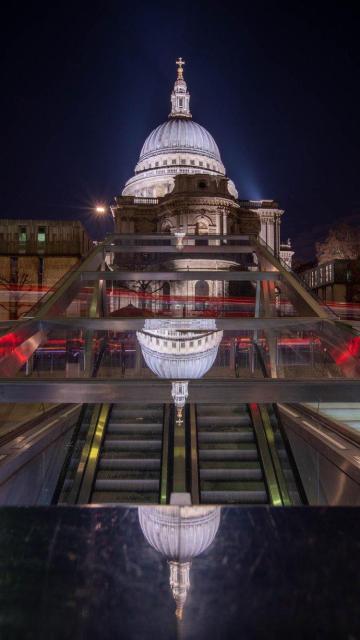 St. Paul's Cathedral with reflection in the foreground and light trails from a London bus
St. Paul's Cathedral with reflection in the foreground and light trails from a London bus
Leading Lines
Utilize leading lines in the foreground to gracefully guide the viewer's eye through your photograph. These leading lines can take various forms, such as a road, a path, or any linear element that captures attention. In your case, the light trails themselves can act as leading lines, as clearly highlighted in the following example. The smart use of these leading lines adds not only an intriguing visual dimension but also contributes to a photographic composition that unfolds smoothly and engagingly.
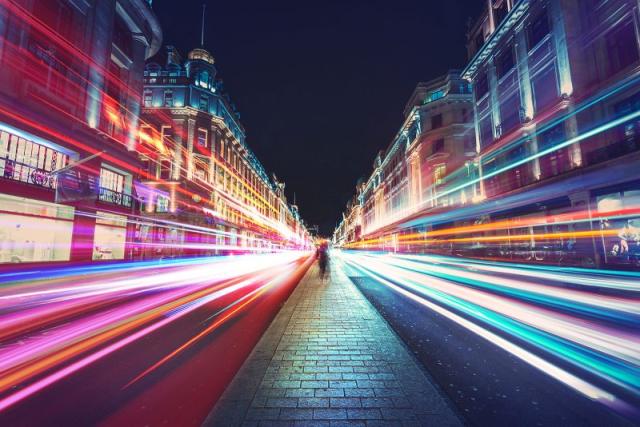
Diagonals
Harness the power of diagonal lines in photography to infuse a sense of dynamism, movement, and energy that seamlessly complements the aesthetics of light trails. Position the light trails strategically in the corners of the frame and have them converge diagonally towards the center of the image. The difference this technique can make to the visual perception of the image is astonishing, as highlighted in the example below of a bus speeding through the iconic Tower Bridge in London.
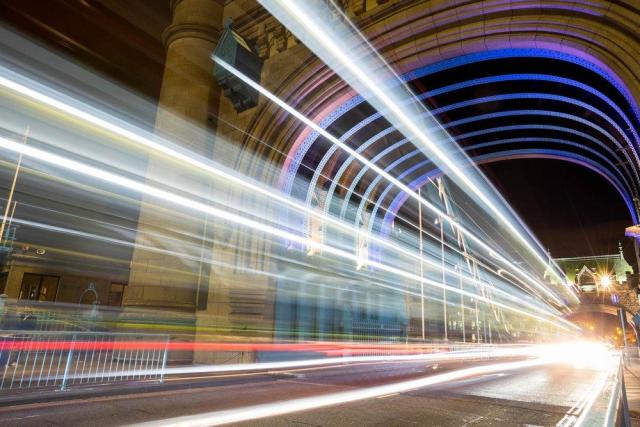
Symmetry
In urban night photography, symmetrical compositions emerge as winning choices. These not only bring order to a scene but also restore balance in the chaos of a metropolis. If you add light trails to this symmetry, you get a winning mix! While it's not an easy technique, the results speak for themselves, as shown in the following example with vehicles crossing the iconic Tower Bridge in London. Always remember to prioritize your safety during the shoot. If you're photographing paths of vehicles from both sides, make sure to position yourself in a safe location!
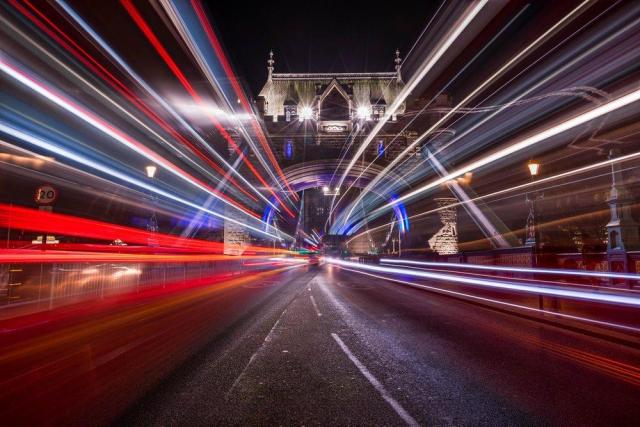
Photographing light trails requires refined framing and composition management, finding a delicate balance between static and dynamic elements, foreground and background, and the light trails streaking through the frame. Experiment with these techniques creatively to bring visually stunning images to life, rich in visual storytelling, capable of capturing attention and captivating your audience.
Camera Settings for Light Trails Photography
To capture captivating light trail photos, careful selection of camera settings is crucial to immortalize the dynamism of vehicles at night. While there's no universal configuration since adjustments are needed for specific lighting conditions, some general guidelines will help you get started on the right foot. Here's a detailed guide on the camera settings necessary to capture compelling light trail images:
Manual Mode
Take full control and set the camera to manual mode to customize each parameter and achieve the desired effect.
Aperture (f-stop)
Opt for a small aperture (f/8 - f/16) to ensure an extended depth of field, keeping both the light trails and the background sharp.
Shutter Speed
Set a slower shutter speed to capture the flow of vehicle lights in transit, usually ranging between 4 and 30 seconds. This range should be adjusted based on traffic speed and the desired length of light trails. If the distance is short, go for a shorter shutter speed; if the distance is considerable, increase the duration of the shutter speed.
Experimentation is crucial in this phase. Try different shutter speed settings to achieve various effects and discover the optimal combination to capture the dynamic movement of vehicles in your composition. This process will allow you to achieve unique and fascinating results.
ISO Sensitivity
Keep the ISO as low as possible (ISO 100-200) to reduce noise and preserve image quality. Low ISO is crucial in long exposures to avoid overexposure.
White Balance
When shooting in an urban environment with various light sources, such as streetlights, car lights, and spotlights on bridges, achieving precise light balance can be challenging due to different color temperatures. In such situations, using automatic white balance (AWB) is preferable. This option provides a reasonable compromise that can be further adjusted during post-processing.
It's important to note that to fully benefit from this option, it's advisable to shoot photos in RAW format. This allows greater flexibility during the post-processing phase, enabling you to further refine white balance for optimal results.
Focus
Often, it's advisable to set the focus manually to infinity in nighttime light trails photography. This choice ensures that both the light trails and the background remain sharp. In low-light conditions, automatic focus may struggle, so relying on manual focus is considered more reliable to ensure optimal results.
Shoot in RAW
Opt for the RAW format to maximize information and gain more flexibility in post-production. RAW files allow more in-depth adjustments of exposure, color balance, and sharpness.
Exposure Bracketing
Consider using exposure bracketing if you have uncertainties about the optimal settings. This technique involves capturing multiple shots with different exposures, providing you with a range of options during the post-processing phase.
By fine-tuning these complex camera settings, you can capture extraordinary light trail photos, transforming the night into a fascinating and creative light show.
Timing and Patience
The timing of your exposure is crucial. Wait for the right moment when multiple vehicles are in the frame. Patience is key: it might take several attempts to capture the perfect shot. The success of nighttime light trail photography often requires a combination of skill, planning, and a bit of luck!
Understanding traffic patterns, experimenting with exposure settings, and exercising patience will increase your chances of capturing that perfect moment when the night comes alive with sparkling lights.
So, find a comfortable spot, prepare your equipment, and experience the excitement of timing and patience in the world of nighttime photography.
Post-Processing for Light Trails Photography
While capturing the essence of light trails during the shot is crucial, post-processing plays a significant role in refining the images and bringing out their full potential. Software like Adobe Lightroom or Photoshop can assist you in enhancing colors, contrast, and image sharpness. You can also correct any minor imperfections and add creative effects if desired.
Post-processing is a creative and personal process, much like photography. However, there are generalized processing techniques that will transform any light trail image. Below, you'll find a guide on how to improve light trail photographs during the post-processing phase:
Organize Your Files First
Start by importing your images into photo editing software like Adobe Lightroom or Capture One. Organize your files systematically for easy access and processing. Correcting this part from the beginning will save you hours of time in the future!
Basic Adjustments
Exposure and Contrast: Begin by adjusting the overall exposure and contrast. Ensure that the light trails stand out against the background without losing details. Refine these settings to achieve an optimal balance.
White Balance: Fine-tune the white balance if necessary. Experiment with cooler or warmer tones to enhance the overall atmosphere of the image.
Color Correction Vividness and Saturation: Adjust levels of vividness and saturation to enhance the colors of the image. Be careful not to oversaturate, aiming for a balance that enriches the overall atmosphere of the photo.
HSL/Color Grading: Use Hue, Saturation, and Luminance (HSL) tools or color grading tools to selectively adjust specific colors. This allows you to optimize the appearance of individual tones in light trails, bringing harmonious color balance to the scene.
Sharpness and Clarity
Sharpness: Apply the right amount of sharpness to enhance image details. Avoid overdoing sharpness, as it may cause unwanted artifacts.
Clarity: Adjust the clarity slider to improve contrast in mid-tones. This can add definition to light trails and bring out complex details. Be careful not to overdo clarity, seeking a balance that accentuates details without making the image too artificial.
Noise Reduction
Long exposures, especially in low-light conditions, can introduce digital noise if a higher ISO is used. Use noise reduction tools to mitigate this effect, aiming to preserve image details. However, be cautious not to overdo noise reduction, as it may result in the loss of important details and flatten the image. Find a balance that reduces noise without compromising the overall quality of the image.
Lens Corrections
Apply lens corrections to fix any distortions or vignetting introduced by the lens. This ensures a more uniform and aesthetically pleasing result. Eliminating distortions and vignetting will contribute to achieving a cleaner and more professional-looking image, enhancing the overall quality of your photograph.
Cropping and Composition Refinement
Cropping for Better Impact: Refine the composition through cropping. Remove distractions and reframe the image to improve the visual impact of light trails.
Straighten Horizons: Ensure that horizons are straightened for a refined and professional appearance. This is particularly relevant when shooting in urban environments with distinct horizontal lines. Keeping horizons well-aligned will contribute to providing a sense of order and precision to your photograph.
Overlay and Blending (Advanced Technique)
Multiple Exposure Overlay: If you've captured multiple exposures, consider stacking them for a more intricate light trail effect. This involves combining different shots to emphasize the density and complexity of light trails.
Blending for Dynamic Elements: Experiment with blending techniques to enhance specific elements in your composition. For instance, use blending methods to emphasize reflections or stationary objects.
Creative Effects
Adding Filters and Overlays: Explore creative possibilities by adding filters or overlays. This could include introducing subtle gradients, lens flares, or other effects to enhance the overall atmosphere of the image.
Color Grading for Atmosphere: Deepen color grading techniques to create a specific atmosphere or mood. Adjust tones to evoke a sense of warmth, coolness, or mystery in your light trail photographs. These adjustments will add a unique touch to your images, making them even more engaging for viewers.
By meticulously applying these post-processing techniques, you can transform your light trail images into captivating works of art. Remember, the goal is not to overshadow the intrinsic beauty of light trails but to perfect and accentuate their impact, creating a final composition that truly mesmerizes your audience. Experiment with different options and leave room for your creativity to explore new ways of interpreting and presenting your photographs. Good luck in capturing and transforming the fascinating world of vehicle light trails!
Conclusions
Nighttime light trails photography is an exciting genre that allows you to capture the excitement of movement and light. With the right equipment, choice of compelling locations, appropriate camera settings, and a touch of creativity, you can create extraordinary images that tell a compelling story of nighttime energy.
So, grab your camera, choose an interesting location, and immerse yourself in the fascinating world of nighttime vehicle light trails photography. With patience, exploration, and passion, you'll capture unique moments and turn them into visually stunning works of art. Happy hunting for light trails, and may each of your photos tell a memorable nighttime story!
When you subscribe to the blog, we will send you an e-mail when there are new updates on the site so you wouldn't miss them.
By accepting you will be accessing a service provided by a third-party external to https://www.insightadv.it/


































































Comments